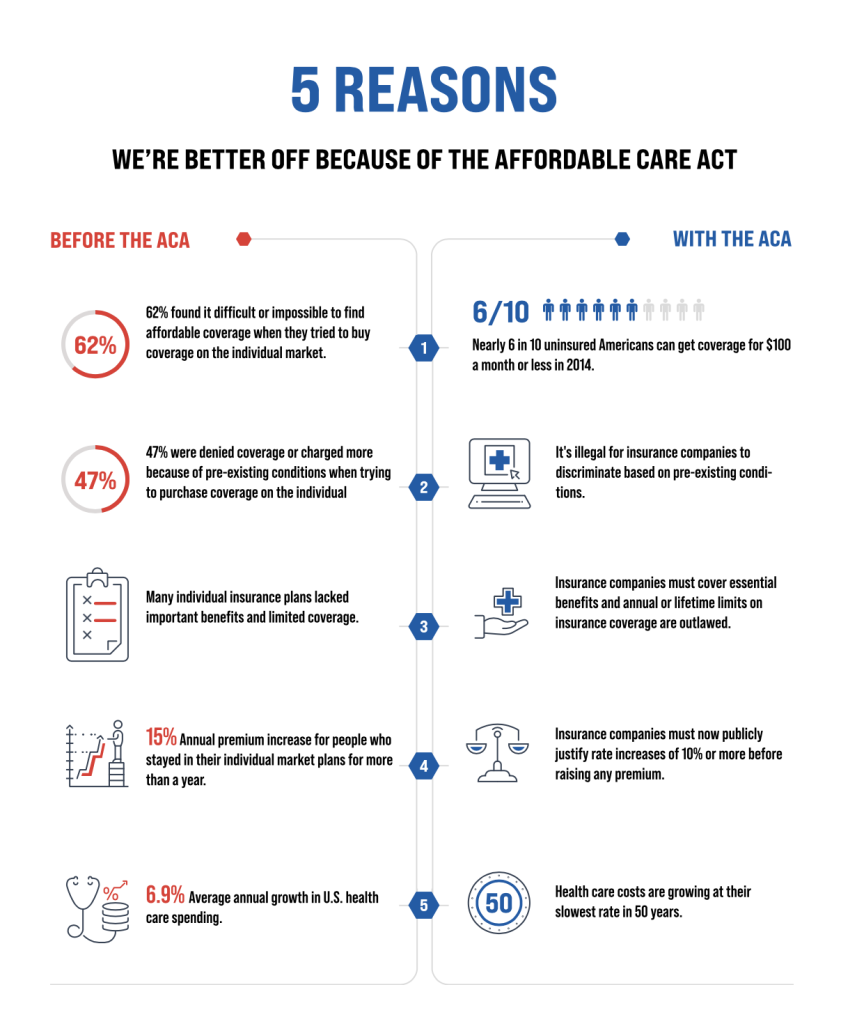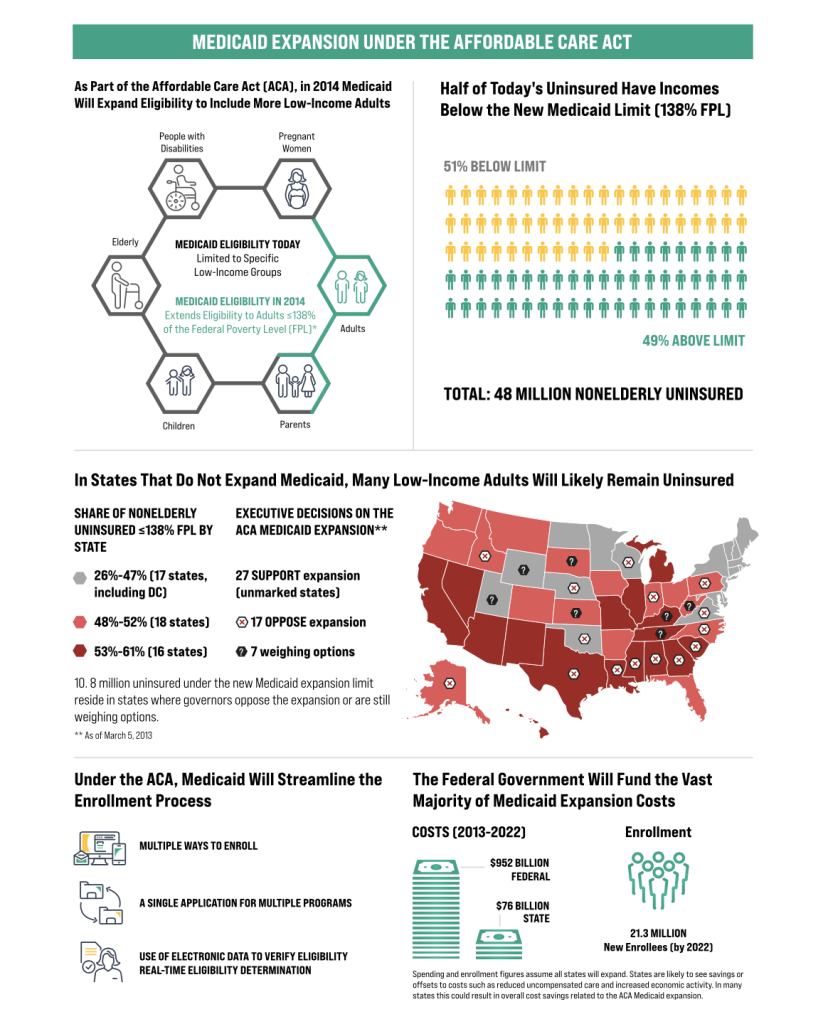Introduction
If it’s an age old adage that you are what you eat, then it is just as true that you are most contented when you have your health.
Healthcare is a crucial part of a happy, well-lived life, but unfortunately for millions of Americans, the rising costs of doctor’s visits and medicines means making tough choices between paying for the healthcare they desperately need, or paying for some other necessity like food, utilities or housing. But it doesn’t have to be this way—there is help.
In recent decades the government has taken great strides in not only making healthcare more affordable, but also more accessible, making it clear that this is a top priority. Where previously it might be difficult for a patient to receive coverage based on things like age, weight, or preexisting conditions, today the government has put in place regulations broadly guaranteeing that the majority of Americans can receive safe, effective coverage as a basic right and necessity.
The Affordable Care Act
The Affordable Care Act, also known as the ACA, is a landmark movement that was enacted in 2010 as a way to provide some of the widest healthcare coverage in American history. When paired with the Health Care and Education Reconciliation Act of 2010, it is the American healthcare system’s biggest growth and regulatory coverage change since Medicaid and Medicare’s creation, which took place back in 1965. [1]
Some of the hallmarks of this Act include:
- Guaranteed coverage by the state for minor children who are not already covered by their parents’ insurance
- Americans must be provided with essential health benefits, which include items like ambulances and emergency response services, maternity and newborn baby care, emergency hospitalization, mental health services, support for substance abuse and addiction, and rehabilitation programs
- And insurers are prohibited from denying coverage to patients with preexisting coverage, which was a major issue previously for millions of Americans
- The ACA also has a focus on preventative care, with healthcare categories focused on nutrition and healthy, accessible foods; contraception and family planning education; and counseling.
How to Apply for Coverage Through the ACA
Like many federal support programs, it is easiest to receive healthcare coverage through the Affordable Care Act by going through your state. Visiting HealthCare.gov will give you an easy to use lookup system where you can search for options based on your state or zip code. Eligibility is not universal, but will likely apply to the majority of Americans. So long as you are a United States citizen, nonelderly, and at an income at or below 138 percent of the federal poverty level, you should have no problem taking part.
Accessible Healthcare for Senior Citizens
You may have noticed we mentioned that the ACA is designed mostly to help “nonelderly” patients. If you fall into the category of senior citizen, that’s where Medicare comes in. It’s a term you’ve likely heard before, as it’s one of the longest running healthcare programs still in existence today. But if you’re new to Medicare, or if you are just now reaching the age group where you’ll need to start participating, we’ve lined out the basic principles of the program to help you better understand what it is, how it works, and who it benefits.
What is Medicare?
In its simplest explanation, Medicare is the United States government’s program for health coverage for US citizens who are aged 65 and over. This program is also designed to help support youths with disabilities, a fact some people might be surprised to learn.
The program was originally created in 1965 and overseen by the Social Security Administration (SSA), though today it falls under the Centers for Medicare and Medicaid Services. It is a wide reaching program—in 2022 alone, 65 million Americans received health insurance thanks to Medicare, according to the 2023 Medicare Trustees Report. Typically, patients covered under this act pay some part of their coverage, either out of pocket, from retirement savings, or through a private insurance plan. However, Medicare spending went well over $900 billion in 2022, per that same Trustees Report.
How to Sign Up for Medicare
There are two basic ways participants sign up for Medicare: automatic enrollment and filling out an application online.
If you retire, and or begin receiving social security benefits, you will likely be automatically enrolled and eligible for Medicare benefits. If you reach the age of 65 and are not yet receiving social security benefits because you are still working and not ready to retire, you are likely still eligible but will need to physically fill out an application online, at ssa.gov/medicare/sign-up
If you are unsure about your enrollment status or eligibility, you can visit usa.gov/medicare
Please remember that if you are under the age of 65 and have a disability, end stage renal disease, or Lou Gehrig’s Disease (ALS), you may also be eligible to receive Medicare benefits.
Medicaid
If you’ve heard of Medicare, you’ve likely heard of Medicaid. In fact, the two programs are often uttered in the same breath, as if they are two sides of the same coin. But Medicaid differs in many ways from Medicare, and it is important that you understand these differences so you can select the healthcare aid program that is going to benefit yourself and your family the most.
In its simplest explanation, Medicaid is a program that supports adults and children with limited resources and income, by providing safe, accessible healthcare options.[2]

Medicaid Eligibility
The most eligible individuals for Medicaid are going to be those that fall under an income level defined by your state. Medicaid is also designed to aid vulnerable populations like pregnant women, children, the disabled, or people who are certified blind. If you have concerns about your specific eligibility based on your income level, you can learn more at healthcare.gov/lower-costs/
What Medicaid Covers
Fortunately, Medicaid covers a wide range of healthcare needs as well as emergencies. You can expect your plan to provide insurance for eventualities like preventative care and checkups, dental and vision care, emergency hospital visits and residential care stays, foot care, mental health counseling, substance abuse and rehabilitation care, vaccines and more.
Children’s Health Insurance Program
Finally, let’s look at arguably the most vulnerable population in our country—the children. CHIP, or the Children’s Health Insurance Program, is designed to provide health insurance coverage for children in households with parents who earn too much to qualify for Medicaid, but are still struggling to cover the rising costs of pediatrician’s visits and other medical care. [3] CHIP can cover things like annual checkups, eye exams, inoculations, needed prescriptions, and more.
Parents can easily sign up their kids ages 19 and under one of two ways: fill out and submit an application at healthcare.gov/create-account or call in your application at 1-800-318-2596.
Important note: you can apply for Medicaid and/or CHIP benefits at any time; it is considered open enrollment with an acknowledgement that needs can change overnight, and once you qualify your coverage can begin immediately.

Sources
- [1] Affordable Care Act (ACA): What It Is, Key Features, and Updates (investopedia.com)
- [2] Status of State Medicaid Expansion Decisions: Interactive Map | KFF
- [3] Children’s Health Coverage: Medicaid, CHIP and the ACA | KFF
Introduction
If it’s an age old adage that you are what you eat, then it is just as true that you are most contented when you have your health.
Healthcare is a crucial part of a happy, well-lived life, but unfortunately for millions of Americans, the rising costs of doctor’s visits and medicines means making tough choices between paying for the healthcare they desperately need, or paying for some other necessity like food, utilities or housing. But it doesn’t have to be this way—there is help.
In recent decades the government has taken great strides in not only making healthcare more affordable, but also more accessible, making it clear that this is a top priority. Where previously it might be difficult for a patient to receive coverage based on things like age, weight, or preexisting conditions, today the government has put in place regulations broadly guaranteeing that the majority of Americans can receive safe, effective coverage as a basic right and necessity.
The Affordable Care Act
The Affordable Care Act, also known as the ACA, is a landmark movement that was enacted in 2010 as a way to provide some of the widest healthcare coverage in American history. When paired with the Health Care and Education Reconciliation Act of 2010, it is the American healthcare system’s biggest growth and regulatory coverage change since Medicaid and Medicare’s creation, which took place back in 1965. [1]
Some of the hallmarks of this Act include:
- Guaranteed coverage by the state for minor children who are not already covered by their parents’ insurance
- Americans must be provided with essential health benefits, which include items like ambulances and emergency response services, maternity and newborn baby care, emergency hospitalization, mental health services, support for substance abuse and addiction, and rehabilitation programs
- And insurers are prohibited from denying coverage to patients with preexisting coverage, which was a major issue previously for millions of Americans
- The ACA also has a focus on preventative care, with healthcare categories focused on nutrition and healthy, accessible foods; contraception and family planning education; and counseling.
How to Apply for Coverage Through the ACA
Like many federal support programs, it is easiest to receive healthcare coverage through the Affordable Care Act by going through your state. Visiting HealthCare.gov will give you an easy to use lookup system where you can search for options based on your state or zip code. Eligibility is not universal, but will likely apply to the majority of Americans. So long as you are a United States citizen, nonelderly, and at an income at or below 138 percent of the federal poverty level, you should have no problem taking part.
Accessible Healthcare for Senior Citizens
You may have noticed we mentioned that the ACA is designed mostly to help “nonelderly” patients. If you fall into the category of senior citizen, that’s where Medicare comes in. It’s a term you’ve likely heard before, as it’s one of the longest running healthcare programs still in existence today. But if you’re new to Medicare, or if you are just now reaching the age group where you’ll need to start participating, we’ve lined out the basic principles of the program to help you better understand what it is, how it works, and who it benefits.
What is Medicare?
In its simplest explanation, Medicare is the United States government’s program for health coverage for US citizens who are aged 65 and over. This program is also designed to help support youths with disabilities, a fact some people might be surprised to learn.
The program was originally created in 1965 and overseen by the Social Security Administration (SSA), though today it falls under the Centers for Medicare and Medicaid Services. It is a wide reaching program—in 2022 alone, 65 million Americans received health insurance thanks to Medicare, according to the 2023 Medicare Trustees Report. Typically, patients covered under this act pay some part of their coverage, either out of pocket, from retirement savings, or through a private insurance plan. However, Medicare spending went well over $900 billion in 2022, per that same Trustees Report.
How to Sign Up for Medicare
There are two basic ways participants sign up for Medicare: automatic enrollment and filling out an application online.
If you retire, and or begin receiving social security benefits, you will likely be automatically enrolled and eligible for Medicare benefits. If you reach the age of 65 and are not yet receiving social security benefits because you are still working and not ready to retire, you are likely still eligible but will need to physically fill out an application online, at ssa.gov/medicare/sign-up
If you are unsure about your enrollment status or eligibility, you can visit usa.gov/medicare
Please remember that if you are under the age of 65 and have a disability, end stage renal disease, or Lou Gehrig’s Disease (ALS), you may also be eligible to receive Medicare benefits.
Medicaid
If you’ve heard of Medicare, you’ve likely heard of Medicaid. In fact, the two programs are often uttered in the same breath, as if they are two sides of the same coin. But Medicaid differs in many ways from Medicare, and it is important that you understand these differences so you can select the healthcare aid program that is going to benefit yourself and your family the most.
In its simplest explanation, Medicaid is a program that supports adults and children with limited resources and income, by providing safe, accessible healthcare options.[2]

Medicaid Eligibility
The most eligible individuals for Medicaid are going to be those that fall under an income level defined by your state. Medicaid is also designed to aid vulnerable populations like pregnant women, children, the disabled, or people who are certified blind. If you have concerns about your specific eligibility based on your income level, you can learn more at healthcare.gov/lower-costs/
What Medicaid Covers
Fortunately, Medicaid covers a wide range of healthcare needs as well as emergencies. You can expect your plan to provide insurance for eventualities like preventative care and checkups, dental and vision care, emergency hospital visits and residential care stays, foot care, mental health counseling, substance abuse and rehabilitation care, vaccines and more.
Children’s Health Insurance Program
Finally, let’s look at arguably the most vulnerable population in our country—the children. CHIP, or the Children’s Health Insurance Program, is designed to provide health insurance coverage for children in households with parents who earn too much to qualify for Medicaid, but are still struggling to cover the rising costs of pediatrician’s visits and other medical care. [3] CHIP can cover things like annual checkups, eye exams, inoculations, needed prescriptions, and more.
Parents can easily sign up their kids ages 19 and under one of two ways: fill out and submit an application at healthcare.gov/create-account or call in your application at 1-800-318-2596.
Important note: you can apply for Medicaid and/or CHIP benefits at any time; it is considered open enrollment with an acknowledgement that needs can change overnight, and once you qualify your coverage can begin immediately.

Sources
- [1] Affordable Care Act (ACA): What It Is, Key Features, and Updates (investopedia.com)
- [2] Status of State Medicaid Expansion Decisions: Interactive Map | KFF
- [3] Children’s Health Coverage: Medicaid, CHIP and the ACA | KFF




